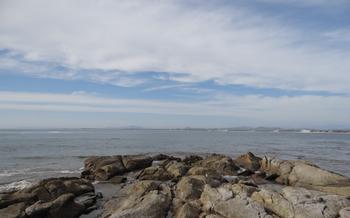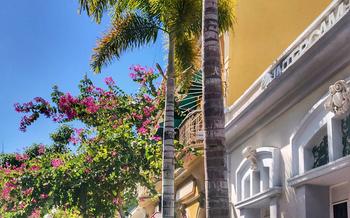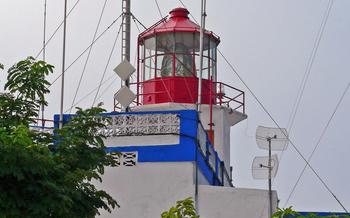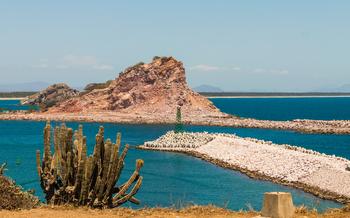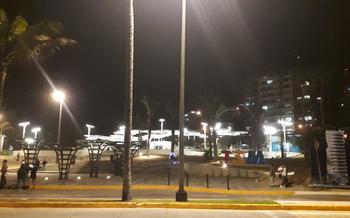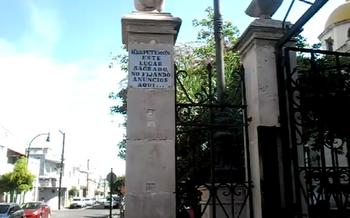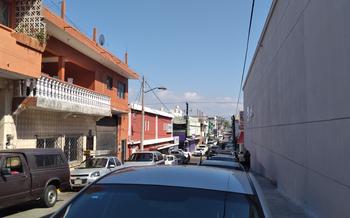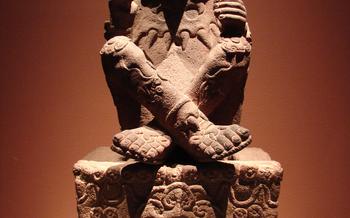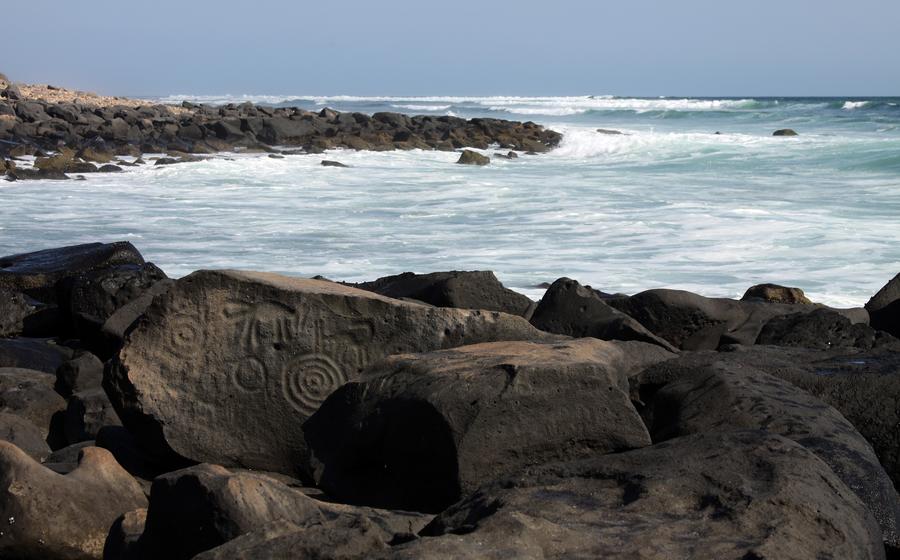
Las Labradas Petroglyphs
- The Antiquity of Las Labradas Petroglyphs
- Location and Accessibility:
- The Petroglyphs Themselves: A Glimpse into Ancient Symbolism
- Exploring the Site
- Guided Tours
- Photography Tips:
- Cultural Significance
- Conservation Efforts
- Nearby Attractions
- Accommodation Options
- Safety and Security
- Weather and Climate
- Responsible Tourism
- Insider Tip: Unveiling the Hidden Charm of Isla de Lobos
The Antiquity of Las Labradas Petroglyphs
Delving into the depths of time, the Las Labradas Petroglyphs stand as a testament to the rich cultural heritage of Mexico. These enigmatic etchings, carved into volcanic rocks overlooking the Pacific Ocean, have captivated the imaginations of historians, archaeologists, and travelers alike. Their origins remain shrouded in mystery, with theories suggesting their creation by ancient Mesoamerican civilizations such as the Olmecs or the Aztecs. The petroglyphs depict a diverse array of subjects, from human figures and animals to abstract symbols, each holding a unique story yet to be fully deciphered. The site's spiritual significance is palpable, as it is believed to have been a sacred place where ancient rituals and ceremonies took place. Local legends and folklore further enhance the allure of these ancient masterpieces, adding a layer of enchantment to their already enigmatic presence.
Location and Accessibility:
Las Labradas Petroglyphs are situated on the Pacific coast of Mexico, approximately 35 kilometers north of the vibrant city of Mazatlan in the state of Sinaloa. This unique site is nestled amidst a stunning landscape of towering cliffs, pristine beaches, and lush vegetation. To reach Las Labradas, visitors can embark on a scenic drive along Highway 15, which offers breathtaking views of the coastline. Alternatively, adventurous travelers can opt for a leisurely boat trip from Mazatlan, allowing them to soak in the beauty of the Pacific Ocean.
Upon arrival at Las Labradas, visitors are greeted by a well-maintained site that is easily accessible and open to the public. The entrance to the petroglyph zone is marked by a small fee booth, where visitors can purchase tickets and obtain any necessary permits. The site features clearly marked trails and viewing platforms that lead visitors to the various petroglyphs, making it easy to explore the site at your own pace.
The Petroglyphs Themselves: A Glimpse into Ancient Symbolism
The Las Labradas Petroglyphs are a captivating collection of rock carvings that offer a unique glimpse into the minds and beliefs of ancient civilizations. These mysterious etchings adorn the surface of large boulders, narrating stories and depicting symbols that have puzzled and fascinated researchers for centuries.
The petroglyphs vary in size and complexity, ranging from simple geometric shapes to intricate scenes depicting animals, humans, and mythical creatures. Some petroglyphs feature abstract designs, while others showcase recognizable forms like turtles, snakes, and deer. The techniques used to create these engravings are equally diverse, with some petroglyphs exhibiting deep incisions, while others appear more shallow and weathered.
The symbolism and motifs depicted in the petroglyphs are a source of ongoing debate among scholars. Some believe that the petroglyphs hold religious or spiritual significance, serving as a form of communication with the divine. Others suggest that they were created for practical purposes, such as marking territorial boundaries or recording important events.
One of the most intriguing petroglyphs at Las Labradas is known as "The Turtle." This large engraving depicts a turtle with intricate patterns adorning its shell. Some researchers believe that the turtle represents a symbol of fertility and longevity, while others suggest that it may have been created to honor a revered ancestor or deity.
Another notable petroglyph is referred to as "The Fisherman." This engraving showcases a human figure holding a fishing net, surrounded by various sea creatures. It is believed that this petroglyph was created by a fishing community to ensure a bountiful catch and pay homage to the gods of the sea.
These are just a few examples of the many captivating petroglyphs found at Las Labradas. Each engraving holds its own unique story, inviting visitors to delve deeper into the rich cultural heritage of the region and the lives of the ancient people who created these remarkable artworks.
Exploring the Site
Las Labradas is best explored on foot, allowing you to fully immerse yourself in the ancient artistry and the natural beauty of the surroundings. A suggested route would be to start at the main entrance and follow the well-marked trails that lead you past the various petroglyphs. Take your time, as each petroglyph offers a unique glimpse into the past.
Be sure to visit the "El Laberinto" (The Labyrinth), a cluster of petroglyphs located near the entrance. This area features a maze-like arrangement of rocks, each adorned with intricate carvings. Don't miss the "La Piedra Volada" (The Flying Rock), a massive boulder precariously perched on a smaller rock, creating a striking visual.
As you explore, pay attention to the terrain, which can be uneven and rocky in places. Wear comfortable shoes and be prepared for some light hiking. The site is exposed, so sunscreen, a hat, and sunglasses are essential, especially during the hotter months.
To make the most of your visit, consider bringing binoculars to get a closer look at the petroglyphs. You might also want to bring a notebook and pen to sketch or take notes of your observations.
Guided Tours
Exploring Las Labradas Petroglyphs with a knowledgeable guide can greatly enhance your experience. Guided tours offer several advantages, including:
-
In-depth Knowledge: Guides are well-versed in the history, significance, and symbolism of the petroglyphs. They can provide detailed explanations and answer your questions, enriching your understanding of the site.
-
Customized Experience: Guides can tailor the tour to your interests and pace, ensuring you get the most out of your visit. They can also suggest specific petroglyphs or areas based on your preferences.
-
Cultural Insights: Guides often share cultural insights and stories about the petroglyphs and their connection to local communities. This adds a deeper layer of appreciation and understanding to your experience.
When choosing a guided tour, consider reputable tour operators or guides with experience and knowledge of the site. Read reviews and ask for recommendations to ensure you have a positive experience.
During the tour, be sure to engage with your guide, ask questions, and share your thoughts. This interaction will make the experience more interactive and memorable.
Photography Tips:
Capturing the essence of Las Labradas Petroglyphs through photography requires skill and patience. The best lighting conditions for photography are early morning or late afternoon, when the sun's rays cast long shadows that accentuate the details of the petroglyphs. Experiment with different angles and perspectives to create dynamic compositions. A tripod is essential for stable shots, especially in low-light conditions. Use a wide-angle lens to capture the vastness of the site and a telephoto lens for close-ups of specific petroglyphs. Polarizing filters can reduce glare and enhance the contrast of the carvings. Respect the fragility of the petroglyphs and avoid touching or disturbing them in any way. Above all, let your creativity flow and embrace the opportunity to document this ancient masterpiece.
Cultural Significance
The Las Labradas Petroglyphs hold immense cultural significance for the local communities of Mazatlan. They are considered a testament to the rich history and cultural heritage of the region. The petroglyphs are believed to have been created by the indigenous people who inhabited the area centuries ago, and they continue to be a source of pride and inspiration for the local population.
Oral traditions and folklore often revolve around the petroglyphs, adding to their cultural significance. Stories passed down from generation to generation speak of the spiritual and mystical powers associated with the site. Locals believe that the petroglyphs possess healing properties and that visiting them can bring good luck and protection.
Cultural events and ceremonies are sometimes held near the petroglyphs, further showcasing their importance in the local culture. These events provide opportunities for the community to come together, celebrate their heritage, and pay homage to their ancestors.
As visitors explore the Las Labradas Petroglyphs, it is important to approach the site with respect and cultural sensitivity. This means refraining from touching or defacing the petroglyphs, observing any local customs or restrictions, and listening to the stories and interpretations shared by local guides or community members.
Conservation Efforts
The Las Labradas Petroglyphs are a priceless cultural heritage that requires ongoing preservation and protection. Recognizing their significance, local authorities and organizations have implemented several conservation initiatives to safeguard this ancient site. These efforts aim to ensure that future generations can continue to witness and appreciate the artistry and cultural legacy embodied in these rock carvings.
One of the crucial conservation measures involves regular monitoring and maintenance of the site. Experts conduct thorough assessments to identify potential threats and implement necessary actions to mitigate them. This includes cleaning and removing debris from the petroglyphs, addressing erosion issues, and stabilizing unstable rocks.
To prevent damage caused by human activities, controlled access to the site is enforced. Visitors are guided along designated pathways, ensuring that they do not inadvertently harm the petroglyphs or disturb the surrounding environment. Educational signage and guided tours help raise awareness among visitors about the importance of respecting and preserving the site.
Moreover, local communities play a vital role in the conservation efforts. They act as guardians of the petroglyphs, keeping a watchful eye on the site and reporting any suspicious activities or potential threats. Their involvement fosters a sense of ownership and responsibility, ensuring the long-term protection of this cultural treasure.
By supporting conservation initiatives and practicing responsible tourism, visitors can contribute to the preservation of the Las Labradas Petroglyphs. This includes avoiding touching or climbing on the petroglyphs, refraining from using flash photography, and leaving no trace of their visit. Together, we can ensure that this ancient legacy continues to inspire and captivate generations to come.
Nearby Attractions
Your journey to Mazatlan doesn't end with the Las Labradas Petroglyphs. The city and its surroundings offer a plethora of attractions that will captivate your senses and leave you yearning for more.
-
Isla de la Piedra: Embark on a thrilling boat trip to Isla de la Piedra, a picturesque island renowned for its stunning rock formations and crystal-clear waters. Dive into the vibrant marine life by snorkeling or scuba diving, and witness the mesmerizing underwater world.
-
Mazatlan Aquarium: Immerse yourself in the enchanting realm of marine life at the Mazatlan Aquarium. Encounter a diverse array of aquatic creatures, from playful dolphins and majestic sea lions to exotic tropical fish. Learn about the importance of ocean conservation and the delicate balance of marine ecosystems.
-
El Faro Lighthouse: Ascend to the top of El Faro Lighthouse, a historical beacon that has guided seafarers for over a century. Marvel at the panoramic vistas of the city, the glistening ocean, and the distant mountains. Capture breathtaking photographs that will serve as lasting mementos of your Mazatlan adventure.
-
Plazuela Machado: Stroll through the charming Plazuela Machado, the heart of Mazatlan's historic center. Admire the colonial architecture, soak in the lively atmosphere, and indulge in delicious local cuisine at the quaint restaurants and cafes that line the square.
-
Golden Zone: Experience the vibrant energy of the Golden Zone, Mazatlan's bustling tourist hub. Discover an array of shops, restaurants, bars, and nightclubs, catering to every taste and preference. Bask in the sun on the beautiful beaches, or take part in thrilling water sports that will leave your adrenaline pumping.
Accommodation Options
Las Labradas offers a diverse range of accommodation options to suit every budget and preference. For those seeking a luxurious and immersive experience, the Pueblo Bonito Mazatlán is a top choice. This beachfront resort boasts elegant rooms and suites, world-class amenities, and stunning views of the Pacific Ocean.
For budget-conscious travelers, the Hotel Playa Mazatlán is an excellent option. Located just steps from the beach, this hotel offers comfortable and affordable rooms, as well as a range of amenities including a swimming pool, restaurant, and bar.
If you prefer a more intimate and local experience, consider staying at one of the many guesthouses or vacation rentals in the area. These accommodations often provide a unique glimpse into the local culture and lifestyle, and can be a great way to connect with the community.
When choosing your accommodation, consider factors such as proximity to the petroglyphs, your budget, and your desired level of comfort and amenities. It's always a good idea to book your accommodation in advance, especially during peak tourist season.
Safety and Security
Mazatlan is generally considered a safe city for tourists, and Las Labradas is no exception. However, as with any travel destination, it's essential to take precautions to ensure your safety. Here are some tips:
-
Be aware of your surroundings: This is especially important when visiting the petroglyphs, as the site is relatively isolated. Be mindful of people around you and avoid walking alone at night.
-
Keep your valuables safe: Don't carry large amounts of cash or valuables with you. Leave your passport and other important documents in a secure place, such as a hotel safe.
-
Be respectful of local customs: Dress modestly and avoid public displays of affection. Respect local laws and regulations, and be mindful of cultural differences.
-
Take a guided tour: If you're concerned about safety, consider taking a guided tour of the petroglyphs. This is a great way to learn about the site's history and culture while staying safe.
-
Trust your instincts: If something feels off, it probably is. Don't hesitate to leave a situation that makes you uncomfortable.
Weather and Climate
Mazatlan enjoys a pleasant and tropical climate year-round, making it an ideal destination for outdoor enthusiasts and beach lovers. The city experiences two distinct seasons: the dry season, which lasts from October to May, and the rainy season, which spans from June to September. During the dry season, temperatures typically hover between 75°F and 85°F (24°C and 29°C), with minimal rainfall. This period is ideal for exploring the city's attractions, including Las Labradas, as the weather is warm and dry.
In contrast, the rainy season brings higher humidity and occasional showers, but it also offers a lush and vibrant landscape. Temperatures remain relatively consistent, ranging from 75°F to 85°F (24°C to 29°C). While some rain is expected during this time, it usually comes in short bursts, allowing for ample opportunities to enjoy the outdoors. If you plan on visiting during the rainy season, be sure to pack a light raincoat or umbrella to stay prepared for any unexpected showers.
To make the most of your visit to Las Labradas, consider the following tips:
- Pack light and airy clothing, as the weather in Mazatlan is generally warm and humid.
- Wear comfortable shoes for walking on uneven terrain and exploring the petroglyphs.
- Apply sunscreen and insect repellent to protect yourself from the sun and insects.
- Stay hydrated by bringing plenty of water, especially during the dry season.
- Check the weather forecast before your visit to be prepared for any changes in conditions.
Responsible Tourism
As a traveler, it's crucial to embrace responsible tourism practices when visiting Las Labradas and Mazatlan. Respecting the local culture and environment should be at the forefront of your mind. Support sustainable businesses that prioritize preserving the region's natural beauty and cultural heritage. Choose tour operators that adhere to ethical principles and give back to the community. Remember, your actions as a tourist can have a significant impact on the destination you're visiting. Be a conscious traveler, minimize your ecological footprint, and leave a positive legacy for future generations to enjoy the wonders of Mazatlan.
Insider Tip: Unveiling the Hidden Charm of Isla de Lobos
Venture beyond the well-trodden paths and discover the enchanting Isla de Lobos, a small island located just a short boat ride from Mazatlan. This hidden gem boasts pristine beaches, crystal-clear waters, and a thriving marine ecosystem. Immerse yourself in the tranquility of this natural paradise, where you can sunbathe, swim, snorkel, or simply relax on the unspoiled shores. Keep your eyes peeled for the playful sea lions that frequent the island, adding an extra layer of charm to this magical destination.
